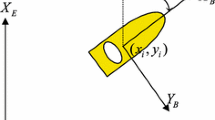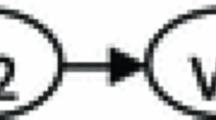Abstract
In this paper, we investigate the distributed formation tracking problem of multiple marine surface vehicles with model uncertainty and time-varying ocean disturbances induced by wind, waves, and ocean currents. The objective is to achieve a collective tracking with a time-varying trajectory, which can only be accessed by a fraction of follower vehicles. A novel predictor-based neural dynamic surface control design approach is proposed to develop the distributed adaptive formation controllers. We use prediction errors, rather than tracking errors, to construct the neural adaptive laws, which enable the fast identification of the vehicle dynamics without incurring high-frequency oscillations in control signals. We establish the stability properties of the closed-loop network via Lyapunov analysis, and quantify the transient performance by deriving the truncated L 2 norms of the derivatives of neural weights, which we demonstrate to be smaller than the classical neural dynamic surface control design approach. We also extend the above result to the distributed formation tracking using the relative position information of vehicles, and the advantage is that the velocity information of neighbors and leader are required. Finally, we give the comparative studies to illustrate the performance improvement of the proposed method.
摘要
创新点
-
(1)
本文提出了一种新型基于预估器的神经网络动态面控制器设计结构, 该结构能够显著地提高系统的暂态控制性能。
-
(2)
本文针对含模型参数不确定与海洋环境扰动下的海洋航行器, 提出了两种分布式队形跟踪控制算法, 所提控制算法仅利用邻居信息进行反馈。
-
(3)
与传统神经网络动态面控制方法采用跟踪误差学习不同, 本文提出采用预估误差进行神经网络权值在线更新, 能够实现对系统不确定性的快速自适应并且避免控制信号振荡。
-
(4)
本文严格证明了所提基于预估器的神经网络动态面控制结构优于传统神经网络动态面控制方法, 即所提控制器结构中神经网络权值导数的截断L2范式更小。
Similar content being viewed by others
References
Jadbabaie A, Lin J, Morse A S. Coordination of groups of mobile autonomous agents using nearest neighbor rules. IEEE Trans Autom Control, 2003, 48: 988–1001
Fax J A, Murray R M. Information flow and cooperative control of vehicle formations. IEEE Trans Autom Control, 2004, 49: 1465–1476
Skjetne R, Moi S, Fossen T I. Nonlinear formation control of marine craft. In: Proceedings of the 41st IEEE Conference on Decision and Control, Las Vegas, 2002, 2: 1699–1704
Ihle I, Arcak F M, Fossen T I. Passivity-based designs for synchronized path following. Automatica, 2007, 43: 1508–1518
Almeida J, Silvestre C, Pascoal A M. Cooperative control of multiple surface vessels in the presence of ocean currents and parametric model uncertainty. Int J Robust Nonlin Control, 2010, 20: 1549–1565
Breivik M, Hovstein V E, Fossen T I. Ship formation control: a guided leader-follower approach. In: Proceedings of the 17th IFAC World Congress, COEX, 2008, 17: 16008–16014
Kyrkjebø E, Pettersen K Y, Wondergem M, et al. Output synchronization control of ship replenishment operations: Theory and experiments. Control Eng Pract, 2007, 15: 741–755
Cui R X, Ge S S, How B V E, et al. Leader-follower formation control of underactuated autonomous underwater vehicles. Ocean Eng, 2010, 37: 1491–1502
Peng Z H, Wang D, Hu X J. Robust adaptive formation control of underactuated autonomous surface vehicles with uncertain dynamics. IET Control Theory Appl, 2011, 5: 1378–1387
Peng Z H, Wang D, Chen Z Y, et al. Adaptive dynamic surface control for formations of autonomous surface vehicles with uncertain dynamics. IEEE Trans Control Syst Tech, 2013, 21: 513–520
Arrichiello F, Chiaverini S, Fossen T I. Formation control of underactuated surface vessels using the Null-Space-Based behavioral control. In: Proceedings of IEEE/RSJ International Conference on Intelligent Robots and Systems, Beijing, 2006. 5942–5947
Ren W. Consensus strategies for cooperative control of vehicle formations. IET Control Theory Appl, 2007, 1: 505–512
Ren W, Sorensen N. Distributed coordination architecture for multi-robot formation control. Robot Auton Syst, 2008, 56: 324–333
Cao Y C, Ren W. Distributed formation control for fractional-order systems: dynamic interaction and absolute/relative damping. Syst Control Lett, 2010, 59: 233–240
Xiao F, Wang L, Chen J, et al. Finite-time formation control for multi-agent systems. Automatica, 2009, 45: 2605–2611
Hong Y G, Hu J P, Gao L X. Tracking control for multi-agent consensus with an active leader and variable topology. Automatica, 2006, 42: 1177–1182
Hu G Q. Robust consensus tracking of a class of second-order multi-agent dynamic systems. Syst Control Lett, 2012, 61: 134–142
Chen W S, Li X B, Jiao L C. Quantized consensus of second-order continuous-time multi-agent systems with a directed topology via sampled data. Automatica, 2013, 49: 2236–2242
Zhang H W, Lewis F L. Adaptive cooperative tracking control of higher-order nonlinear systems with unknown dynamics. Automatica, 2012, 48: 1432–1439
Cui R X, Ren B B, Ge S S. Synchronised tracking control of multi-agent system with high-order dynamics. IET Control Theory Appl, 2011, 6: 603–614
Chen W S, Li X B. Observer-based consensus of second-order multi-agent systems with fixed and stochastically switching topology via sampled data. Int J Robust Nonlin Control, 2014, 24: 567–584
Wang X L, Hong Y G, Huang J, et al. A distributed control approach to a robust output regulation problem for multi-agent linear systems. IEEE Trans Automatic Control, 2010, 55: 2891–2895
Hong Y G, Wang, X L, Jiang Z P. Distributed output regulation of leader-follower multi-agent systems. Int J Robust Nonlin Control, 2013, 23: 48–66
Li Z K, Duan Z S, Chen G R, et al. Consensus of multiagent systems and synchronization of complex networks: a unified viewpoint. IEEE Trans Circ Syst, 2010, 57: 213–224
Wen G H, Duan Z S, Yu W W, et al. Consensus in multi-agent systems with communication constraints. Int J Robust Nonlin Control, 2012, 22: 170–182
Zhang H W, Lewis F L, Das A. Optimal design for synchronization of cooperative systems: state feedback, observer and output feedback. IEEE Trans Autom Control, 2011, 56: 1948–1952
Zhang H W, Lewis F L, Qu Z H. Lyapunov, adaptive, and optimal design techniques for cooperative systems on directed communication graphs. IEEE Trans Ind Electron, 2012, 59: 3026–3041
Li Z K, Liu X D, Ren W, et al. Distributed tracking control for linear multi-agent systems with a leader of bounded unknown input. IEEE Trans Autom Control, 2012, 58: 518–523
Wen G H, Duan Z S, Chen G R, et al. Consensus tracking of multi-agent systems with lipschitz-type node dynamics and switching topologies. IEEE Trans Circ Syst I: Regular Papers, 2014, 61: 499–511
Chen W S, Li X B, Ren W, et al. Adaptive consensus of multi-agent systems with an unknown control directions based on a novel nussbaum-type function. IEEE Trans Autom Control, 2014, 59: 1887–1892
Li Z K, Duan Z S, Lewis F L. Distributed robust consensus control of multi-agent systems with heterogeneous matching uncertainties. Automatica, 2014, 50: 883–889
Peng Z H, Wang D, Zhang H W, et al. Distributed neural network control for adaptive synchronization of uncertain dynamical multiagent systems. IEEE Trans Neural Netw Learn Syst, 2014, 25: 1508–1519
Du H B, Li S H. Attitude synchronization control for a group of flexible spacecraft. Automatica, 2014, 50: 646–651
Liu T F, Jiang Z P. Distributed formation control of nonholonomic mobile robots without global position measurements. Automatica, 2013, 49: 592–600
Cui R X, Yan W S, Xu D M. Synchronization of multiple autonomous underwater vehicles without velocity measurements. Sci China Inf Sci, 2012, 55: 1693–1703
Krstic M, Kokotovic P V, Kanellakopoulos I. Nonlinear and Adaptive Control Design. New York: John Wiley & Sons, 1995
Li J H, Lee P M, Jun B H, et al. Point-to-point navigation of underactuated ships. Automatica, 2008, 44: 3201–3205
Tee K P, Ge S S. Control of fully actuated ocean surface vessels using a class of feedforward approximators. IEEE Trans Control Syst Tech, 2006, 14: 750–756
Chen M, Ge S S, How B V E, et al. Robust adaptive position mooring control for marine vessels. IEEE Trans Control Syst Tech, 2013, 21: 395–409
How B V E, Ge S S, Choo Y S. Dynamic load positioning for subsea installation via adaptive neural control. IEEE J Ocean Eng, 2013, 35: 366–375
Dai S L, Wang C, Luo F. Identification and learning control of ocean surface ship using neural networks. IEEE Trans Ind Inf, 2012, 8: 801–810
Skjetne R, Fossen T I, Kokotovic P V. Adaptive maneuvering, with experiments, for a model ship in a marine control laboratory. Automatica, 2005, 41: 289–298
Swaroop D, Hedrick J K, Yip P P, et al. Dynamic surface control for a class of nonlinear systems. IEEE Trans Autom Control, 2000, 45: 1893–1899
Wang D, Huang, J. Neural network-based adaptive dynamic surface control for a class of uncertain nonlinear systems in strict-feedback form. IEEE Trans Neural Netw, 2005, 6: 195–202
Wang D. Neural network-based adaptive dynamic surface control of uncertain nonlinear pure-feedback systems. Int J Robust Nonlin Control, 2011, 21: 527–541
Li T S, Wang D, Feng G, et al. A DSC approach to robust adaptive NN tracking control for strict-feedback nonlinear systems. IEEE Trans Syst Man Cybernetics, Part B: Cybernetics, 2010, 40: 915–927
Tong S C, Li Y M, Feng G, et al. Observer-based adaptive fuzzy backstepping dynamic surface control for a class of MIMO nonlinear systems. IEEE Trans Syst Man Cybernetics, Part B: Cybernetics, 2011, 41: 1124–1135
Zhang T P, Ge S S. Adaptive dynamic surface control of nonlinear systems with unknown dead zone in pure feedback form. Automatica, 2008, 44: 1895–1903
Wang M, Liu X, Shi P. Adaptive neural control of pure-feedback nonlinear time-delay systems via dynamic surface technqiue. IEEE Trans Syst Man Cybernetics, Part B: Cybernetics, 2011, 41: 1681–1692
Xu B, Shi Z K, Yang C G, et al. Composite neural dynamic surface control of a class of uncertain nonlinear systems in strict-feedback form. IEEE Trans Cybernetics, 2014, 44: 2626–2660
Yoo S J. Distributed consensus tracking for multiple uncertain nonlinear strict-feedback systems under a directed graph. IEEE Trans Neural Netw Learn Syst, 2013, 24: 666–672
Cao C Y, Hovakimyan N. Novel L1 neural network adaptive control architecture with guaranteed transient performance. IEEE Trans Neural Netw, 2007, 18: 1160–1171
Nguyen N T, Ishihara A K. Robust adaptive optimal control modification with large adaptive gain. In: American Control Conference, St Louis, 2009. 2581–2586
Yucelen T, Haddad W M. Low-frequency learning and fast adaptation in model reference adaptive control. IEEE Trans Autom Control, 2013, 58: 1080–1085
Fossen T I. Marine Control System, Guidance, Navigation and Control of Ships, Rigs and Underwater Vehicles. Trondheim, Norway, Marine Cyernetics, 2002
Franceschelli M, Gasparri A. On agreement problems with gossip algorithms in absence of common reference frames. In: International Conference on Robotics and Automation, Anchorage, 2010. 4481–4486
Chen M, Chen W H, Wu Q X. Adaptive fuzzy tracking control for a class of uncertain MIMO nonlinear systems using disturbance observer. Sci China Inf Sci, 2014, 57: 012207
Tong S C, Huo B Y, Li Y M. Observer-based adaptive decentralized fuzzy fault-tolerant control of nonlinear large-scale systems with actuator failures. IEEE Trans Fuzzy Syst, 2014, 22: 1–15
Khalil H K. Nonlinear Systems. Upper Saddle River: Prentice Hall, 2002
Stepanyan V, Krishnakumary K, Nguyenz N, et al. Stability and performance metrics for adaptive flight control. In: AIAA Guidance, Navigation, and Control Conference, Chicago, 2009. 1–19
Author information
Authors and Affiliations
Corresponding author
Rights and permissions
About this article
Cite this article
Peng, Z., Wang, D. & Li, T. Predictor-based neural dynamic surface control for distributed formation tracking of multiple marine surface vehicles with improved transient performance. Sci. China Inf. Sci. 59, 92210 (2016). https://doi.org/10.1007/s11432-015-5384-9
Received:
Accepted:
Published:
DOI: https://doi.org/10.1007/s11432-015-5384-9
Keywords
- dynamic surface control
- distributed formation tracking
- predictor
- marine surface vehicles
- neural networks




